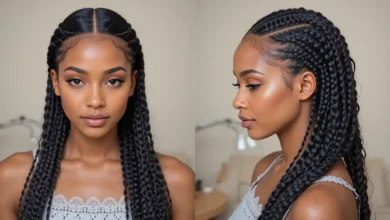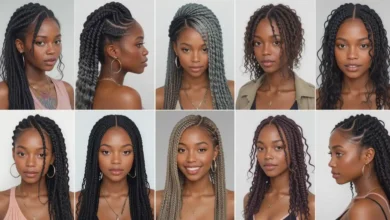Cornrow Braids: Timeless Style with Modern Flair

Cornrow braids have long been celebrated for their intricate designs and cultural significance. Cornrow braids are a traditional African hairstyle that has transcended generations, evolving into a versatile and stylish choice for individuals worldwide. These braids are characterized by their tight, flat-weave patterns that lie close to the scalp, offering both aesthetic appeal and practicality. Whether you’re looking to embrace your heritage, explore creative styles, or maintain low-maintenance hair, cornrow braids provide an array of options to suit every preference. In this comprehensive guide, we will delve into the history, styles, maintenance tips, and modern trends of cornrow braids, helping you achieve the perfect look.
The History and Cultural Significance of Cornrow Braids
The origins of cornrow braids are deeply rooted in African culture, where they served as a means of communication and a symbol of identity. Cornrow braids were traditionally worn by African tribes, each pattern conveying specific messages about the wearer’s social status, age, and tribal affiliation. These braids were not only a form of artistic expression but also a practical way to protect hair from harsh environmental conditions. Over time, cornrow braids spread across the African diaspora, becoming a staple in various communities around the world. Understanding the rich history of cornrow braids adds depth to their modern-day popularity, highlighting their enduring legacy and cultural importance.
Popular Cornrow Braid Styles
Cornrow braids come in a multitude of styles, each offering a unique look and level of complexity. Some of the most popular cornrow braid styles include:
- Straight Back Cornrows: Classic and timeless, these braids run straight from the front to the back of the head.
- Curved Cornrows: Featuring gentle curves, these braids add a dynamic and flowing element to the hairstyle.
- Feed-In Cornrows: These braids incorporate additional hair as they progress, creating a fuller and more seamless appearance.
- Feed-Out Cornrows: Starting with a dense base, these braids gradually loosen towards the ends for a relaxed look.
- Micro Cornrows: Extremely small and tight braids that offer a delicate and intricate design.
- Cornrow Mohawks: Combining the edgy look of a mohawk with the structured pattern of cornrows.
- Patterned Cornrows: Intricate designs and geometric patterns that showcase creativity and skill.
Exploring different cornrow braid styles allows you to find the perfect match for your taste and occasion.
Benefits of Cornrow Braids
Opting for cornrow braids offers numerous benefits beyond their aesthetic appeal. One of the primary advantages of cornrow braids is their ability to protect natural hair from damage and breakage. By keeping the hair tightly braided against the scalp, cornrow braids minimize exposure to environmental stressors such as wind, sun, and friction, promoting healthier hair growth. Additionally, cornrow braids require minimal daily maintenance, making them an excellent choice for those with busy lifestyles. The versatility of cornrow braids allows for various styling options, from simple and sleek to elaborate and decorative, catering to diverse preferences and needs.
How to Achieve Perfect Cornrow Braids
Creating flawless cornrow braids involves a combination of proper technique, patience, and the right tools. Here’s a step-by-step guide to achieving perfect cornrow braids:
- Prepare Your Hair: Start with clean, dry hair. Use a moisturizing spray or leave-in conditioner to hydrate your strands and make them easier to braid.
- Section Your Hair: Divide your hair into even sections using a comb, ensuring that each section is the same size for uniform braids.
- Start Braiding: Begin at the hairline or desired starting point. Take a small section of hair and divide it into three equal strands.
- Begin Cornrowing: Cross the right strand under the middle strand, then the left strand under the new middle strand, maintaining tension throughout.
- Add Hair Gradually: As you braid, incorporate small amounts of additional hair into each section to create the flat-weave effect characteristic of cornrow braids.
- Continue to the Ends: Continue braiding until you reach the ends of your hair, securing each braid with a small elastic or leaving them open for a natural finish.
- Maintain Consistency: Ensure that each braid is tight and even, paying close attention to the spacing and alignment of cornrow braids.
Following these steps will help you achieve beautiful and consistent cornrow braids.
Maintenance Tips for Cornrow Braids
Maintaining cornrow braids is essential to ensure they remain neat, secure, and healthy for an extended period. Here are some maintenance tips for cornrow braids:
- Keep Your Scalp Clean: Gently cleanse your scalp with a diluted shampoo or a specialized scalp cleanser to remove buildup without disturbing the braids.
- Moisturize Regularly: Apply a lightweight oil or moisturizer to keep your scalp hydrated and prevent dryness and itching.
- Avoid Excessive Tension: Ensure that cornrow braids are not braided too tightly, as this can cause discomfort and lead to hair breakage.
- Sleep Protection: Use a satin or silk scarf or pillowcase to reduce friction while sleeping, preventing frizz and unraveling of cornrow braids.
- Protect from Elements: Cover your braids with a hat or scarf during harsh weather conditions to protect them from wind, rain, and excessive sun exposure.
- Regular Touch-Ups: Schedule touch-up sessions to reinforce any loose braids and maintain the integrity of your cornrow braids.
By following these maintenance tips, your cornrow braids will remain stylish and healthy for weeks.
Common Mistakes to Avoid with Cornrow Braids
To ensure your cornrow braids look flawless and last longer, it’s important to avoid some common mistakes:
- Braiding Too Tightly: Tight braiding can lead to scalp irritation and hair breakage. Maintain a comfortable tension while braiding.
- Neglecting Scalp Health: Failing to keep your scalp clean and moisturized can result in dryness and dandruff around the cornrow braids.
- Using Excessive Products: Heavy products can cause buildup and weigh down the braids, making them appear greasy and unkempt.
- Skipping Maintenance: Ignoring regular maintenance can lead to frizz, loose strands, and uneven braids, diminishing the overall appearance of your cornrow braids.
- Poor Sectioning: Inconsistent section sizes can result in uneven cornrow braids that lack symmetry and structure.
Avoiding these mistakes will help you achieve and maintain beautiful cornrow braids.
Styling Ideas with Cornrow Braids
Cornrow braids offer endless styling possibilities, allowing you to express your creativity and personalize your look. Here are some stylish ideas to elevate your cornrow braids:
- Cornrow Ponytail: Gather your cornrow braids into a sleek ponytail for a modern and practical hairstyle.
- Braided Updo: Create an elegant updo by twisting and pinning your cornrow braids into a sophisticated bun or chignon.
- Half Cornrows: Combine cornrow braids with loose, flowing hair for a trendy half-up, half-down style.
- Accessorized Braids: Enhance your cornrow braids with beads, cuffs, or colorful threads for a personalized touch.
- Braided Crown: Form a braided crown around your head for a regal and romantic look.
- Twisted Braids: Incorporate twists and knots into your cornrow braids to add texture and dimension.
These styling ideas demonstrate the versatility and creativity that cornrow braids can bring to your overall appearance.
Choosing the Right Products for Cornrow Braids
Selecting the appropriate products is crucial for maintaining healthy and stylish cornrow braids. Here are some recommended products to enhance your cornrow braids experience:
- Moisturizing Sprays: Keep your braids and scalp hydrated with a lightweight, non-greasy moisturizing spray.
- Edge Control: Use an edge control gel or pomade to smooth down flyaways and define your hairline.
- Anti-Frizz Serum: Apply a small amount of anti-frizz serum to keep your cornrow braids looking sleek and polished.
- Scalp Oils: Nourish your scalp with natural oils like coconut oil, jojoba oil, or olive oil to prevent dryness and promote healthy hair growth.
- Braiding Tools: Invest in quality braiding tools such as a good comb, elastic bands, and braiding needles to ensure precision and ease during the braiding process.
Using the right products will help you achieve and maintain beautiful cornrow braids effortlessly.
The Modern Popularity of Cornrow Braids
In recent years, cornrow braids have experienced a resurgence in popularity, transcending cultural and geographical boundaries. Celebrities, influencers, and fashion icons have embraced cornrow braids, showcasing their versatility and timeless appeal on red carpets, social media, and everyday settings. The modern interpretation of cornrow braids incorporates contemporary trends, such as incorporating vibrant colors, unique patterns, and innovative styling techniques. This renewed interest in cornrow braids has also sparked conversations about cultural appreciation and the importance of recognizing their historical significance. The enduring charm of cornrow braids ensures that they remain a beloved hairstyle choice for generations to come.
How to Transition to Cornrow Braids
Transitioning to cornrow braids from your natural hair or other hairstyles requires careful planning and preparation to maintain hair health. Here are some steps to ensure a smooth transition to cornrow braids:
- Consult a Professional: Seek the expertise of a skilled braider who specializes in cornrow braids to ensure precision and minimize hair damage.
- Prepare Your Hair: Deep condition your hair before getting cornrow braids to ensure it is hydrated and healthy.
- Choose a Suitable Style: Select a cornrow braids style that complements your hair type and personal aesthetic.
- Protect Your Hair: Use a satin or silk scarf at night to protect your cornrow braids and prevent frizz and breakage.
- Maintain Regular Care: Follow a consistent maintenance routine, including cleansing and moisturizing, to keep your cornrow braids and natural hair healthy during the transition.
Conclusion
Cornrow braids are more than just a hairstyle; they are a celebration of culture, creativity, and versatility. From their historical roots to their modern-day adaptations, cornrow braids offer a unique blend of tradition and contemporary style that appeals to a wide range of individuals. Whether you’re seeking a protective hairstyle, a creative expression, or a low-maintenance option, cornrow braids provide endless possibilities to enhance your look. By understanding the various styles, maintenance techniques, and cultural significance of cornrow braids, you can confidently embrace this timeless and elegant hairstyle, showcasing your individuality and honoring its rich heritage.
FAQ
1. What are cornrow braids?
Cornrow braids are a traditional African hairstyle characterized by tight, flat-weave braids that lie close to the scalp, often arranged in intricate patterns and designs.
2. How long can you wear cornrow braids?
Cornrow braids can typically be worn for several weeks, depending on how well they are maintained and the natural growth rate of your hair.
3. Are cornrow braids suitable for all hair types?
Yes, cornrow braids can be adapted to suit various hair types, including straight, wavy, and curly hair, by adjusting the braiding technique and pattern.
4. How do I care for my scalp while wearing cornrow braids?
To care for your scalp while wearing cornrow braids, keep it clean by gently cleansing with a diluted shampoo, moisturizing regularly with lightweight oils, and avoiding excessive tension to prevent irritation.
5. Can cornrow braids promote hair growth?
Yes, cornrow braids can promote hair growth by protecting your natural hair from environmental damage and reducing the need for daily styling, which helps minimize breakage and split ends.





